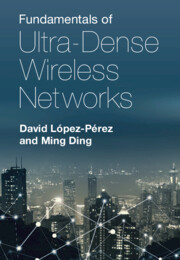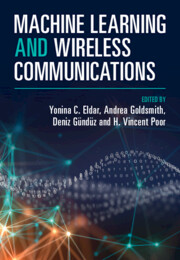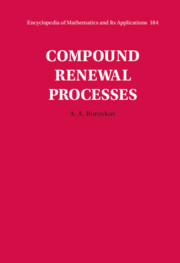Refine listing
Actions for selected content:
9096 results in Communications, Signal Processing and Information Theory
Part IV - Dynamic Time Division Duplexing
-
- Book:
- Fundamentals of Ultra-Dense Wireless Networks
- Published online:
- 17 June 2022
- Print publication:
- 30 June 2022, pp 327-328
-
- Chapter
- Export citation
About the Authors
-
- Book:
- Fundamentals of Ultra-Dense Wireless Networks
- Published online:
- 17 June 2022
- Print publication:
- 30 June 2022, pp xiv-xiv
-
- Chapter
- Export citation
7 - The Impact of Ultra-Dense Wireless Networks on Multi-User Diversity
- from Part II - Fundamentals of Ultra-Dense Small Cell Networks
-
- Book:
- Fundamentals of Ultra-Dense Wireless Networks
- Published online:
- 17 June 2022
- Print publication:
- 30 June 2022, pp 237-278
-
- Chapter
- Export citation
8 - The Ultra-Dense Wireless Networks Capacity Scaling Law
- from Part III - Capacity Scaling Law
-
- Book:
- Fundamentals of Ultra-Dense Wireless Networks
- Published online:
- 17 June 2022
- Print publication:
- 30 June 2022, pp 281-310
-
- Chapter
- Export citation
4 - The Impact of Line-of-Sight Transmissions on Ultra-Dense Wireless Networks
- from Part II - Fundamentals of Ultra-Dense Small Cell Networks
-
- Book:
- Fundamentals of Ultra-Dense Wireless Networks
- Published online:
- 17 June 2022
- Print publication:
- 30 June 2022, pp 103-146
-
- Chapter
- Export citation

Fundamentals of Ultra-Dense Wireless Networks
-
- Published online:
- 17 June 2022
- Print publication:
- 30 June 2022

Machine Learning and Wireless Communications
-
- Published online:
- 16 June 2022
- Print publication:
- 04 August 2022

Compound Renewal Processes
-
- Published online:
- 16 June 2022
- Print publication:
- 30 June 2022
6 - How to Choose a Graph
-
- Book:
- Introduction to Graph Signal Processing
- Published online:
- 09 May 2022
- Print publication:
- 09 June 2022, pp 181-201
-
- Chapter
- Export citation
4 - Sampling
-
- Book:
- Introduction to Graph Signal Processing
- Published online:
- 09 May 2022
- Print publication:
- 09 June 2022, pp 120-148
-
- Chapter
- Export citation
Frontmatter
-
- Book:
- The Fundamentals of Heavy Tails
- Published online:
- 17 May 2022
- Print publication:
- 09 June 2022, pp i-iv
-
- Chapter
- Export citation
5 - Graph Signal Representations
-
- Book:
- Introduction to Graph Signal Processing
- Published online:
- 09 May 2022
- Print publication:
- 09 June 2022, pp 149-180
-
- Chapter
- Export citation
Part I - Properties
-
- Book:
- The Fundamentals of Heavy Tails
- Published online:
- 17 May 2022
- Print publication:
- 09 June 2022, pp 27-28
-
- Chapter
- Export citation
Part III - Estimation
-
- Book:
- The Fundamentals of Heavy Tails
- Published online:
- 17 May 2022
- Print publication:
- 09 June 2022, pp 175-176
-
- Chapter
- Export citation
3 - Graph Signal Frequency – Spectral Graph Theory
-
- Book:
- Introduction to Graph Signal Processing
- Published online:
- 09 May 2022
- Print publication:
- 09 June 2022, pp 75-119
-
- Chapter
- Export citation
7 - Extremal Processes
- from Part II - Emergence
-
- Book:
- The Fundamentals of Heavy Tails
- Published online:
- 17 May 2022
- Print publication:
- 09 June 2022, pp 148-174
-
- Chapter
- Export citation
1 - Introduction
-
- Book:
- Introduction to Graph Signal Processing
- Published online:
- 09 May 2022
- Print publication:
- 09 June 2022, pp 1-28
-
- Chapter
- Export citation
7 - Applications
-
- Book:
- Introduction to Graph Signal Processing
- Published online:
- 09 May 2022
- Print publication:
- 09 June 2022, pp 202-234
-
- Chapter
- Export citation
1 - Introduction
-
- Book:
- The Fundamentals of Heavy Tails
- Published online:
- 17 May 2022
- Print publication:
- 09 June 2022, pp 1-26
-
- Chapter
- Export citation
Preface
-
- Book:
- Introduction to Graph Signal Processing
- Published online:
- 09 May 2022
- Print publication:
- 09 June 2022, pp xiii-xiv
-
- Chapter
- Export citation
